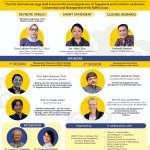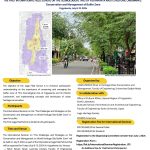May 27, 2006, a traumatic day for the citizens of Jogja, Indonesia. The 5.9 Richter Scale earthquake shook the region. More than six thousands died and many more injured and homeless.
The great earthquake occurred on the 250th anniversary of city of Jogja, the second largest tourism destination in Indonesia after Bali. It is one of the historic cities in the world and also well known as the heart of the Javanese culture. Jogja is the home of thousands of cultural heritages. Borobudur Temple is only 40km away from the city, the Royal Palace of old Mataram Kingdom located in the heart of the city and the old town Kotagede, famous for its silverworks, also a popular tourist destination in Jogja.
Many cultural heritages, tangible and intangible, were severely damaged or collapsed during the earthquake, among others were the World Heritage of Prambanan temple, one of the biggest temple in Java and the wall of the old castle in Jogja which is known as nJeron Beteng. The earthquake also crippled the activities of local industries such as batiks paintings, wood carving, weaving and handicrafts where spread out in the south part of Jogja, called Bantul regent.
Two days after the earthquake, Jogja Heritage Society and Center for Heritage Conservation, Department of Architecture and Planning, Gadjah Mada University in collaboration with many friends and institutions decided to set up a Heritage Post dedicated to the people of Jogja and its valuable heritage. Prince Claus has supported project in Imogiri with Reviving Imogiri Folk Batik
Yogyakarta Indonesia
The Programs for Reviving Imogiri Folk Batik are:
1. Site Preparation and Maintenance
Using approximately 3000 m2 of local resident’s teakwood forest to build physical facilities such as temporary buildings to facilitate crafters’ work. At least there are 9 huts for batik making, 2 huts for natural coloring process, 1 hut used as resting area and goods storage, 1 hut for batik flea market.
The process takes 3 months, using local material such as bamboo and ’bligon’ flooring. Today, almost all bamboo huts have been functioned.
For landscape area we keep the existing teakwood trees and add “living pharmacy” plants
On Stage I, we planned a site preparation for bamboo house as workshop arena in area of 3000 square metres. On Stage II, the site preparation and maintenance include landscape design for Teakwood area that has been changed into “living pharmacy” and as playground.
The overall prepared site is finally used for natural batik process learning space. It is also prepared to highly appreciate the surrounding nature.
2. A. Workshop Activities for 40 crafters
Batik painting activities were initiated using local resident’s frontyard as workshop areas in Pajimatan Village, Girirejo, by involving 35 women batik crafters from local village and its surroundings, especially from Kedung Buwen Village, Karangkulon Village and Giriloyo village. The batik crafters are between 20 to 65 years of age.
In general the batik crafters have a diverse range of technical skills. Not only do they paint batik, they also do the batik natural coloring process. During working hours some crafters take their youngest child with them to be looked after while they are working.
On Stage II batik making activity is followed by 35 batik crafters and 10 crews. Working hour begins at 08.00 to 14.00.
B. Public Batik Painting Workshop
On Stage II, the development of activity program is aimed for batik painting workshop for public. We collaborated with some schools/ educational institutions to have programs on introducing batik making process as well as trainings on batik making process and natural colouring.
In addition to arranging batik workshop for public which is held twice a month, we also offer this activity to students, from kindergarten to junior high school students.
This activity’s objections are:
- To introduce batik making process to students
- To introduce Bantulan batik pattern to children and students and to give them knowledge on how important batik as intangible heritage so that they can appreciate batik. In the future they will have consciousness to preserve the skills of making Bantulan batik.
- To invite children and students to appreciate the nature in “Batik Park” or batik workshop area erected in the middle of teakwood area.
- To invite children and students to appreciate “Houses” made by bamboo as traditional material and also to introduce children that bamboo has many kinds and forms.
We arrange Heritage Trail for introducing batik making process as well as inviting children to be close to nature and giving them knowledge on the importance of batik preservation in such a fun way.
We also have programs for tourists from foreign countries to stay in for one week in Pajimatan to learn batik making process. The one week learning process includes:
- One day theory of batik making
- Three day training of using canting on a cloth and batik drawing
- The rest of two days are used to do natural colouring and finishing / removing the wax on the cloth.
3. Batik Material and Process
The entire production process of handmade batik were held at Pajimatan workshop, beginning with drawing, waxing, to coloring batik with natural colour. The process of batik colouring use natural materials such as barks, leaves, and dried fruits.
In addition to offering training and workshops for students and tourists, we also have exchange program with batik crafters from different areas, for example with batik crafters from Lasem. For five days they make comparative study of natural colouring in Pajimatan workshop. The programs are:
- Theories of natural colouring. In the training, the participants learned about natural colouring from the experts specially invited from Balai Batik.
- The participants applied what they learned in the field.
4.Batik Crafts Flea Market
Batik Craft Flea Market opens daily. The site was formerly a small restaurant named “Andaningrum”. This restaurant was damaged by the earthquake and is currently a temporary site for the Batik Flea Market. Upon completion of the hut designated for this market, it will be moved to the hut.
The Batik Craft Flea Market sells batik crafts made by local crafters. It also sells traditional food. Visitors can buy batik crafts and watch the process of batik painting, all in one location. Visitors in Batik Flea market area can buy various batik collections made by local crafters especially classical Mataraman and Bantulan batik style.
Batik crafts Flea Market is located in the same area with temporary Imogiri Eco-Museum. Visitors do not come to buy batik very often instead they prefer to see batik making process in Pajimatan workshop area.
- The Temporary Imogiri Eco-Museum establishment
The original ”Joglo Ciptowening” batik eco-museum was severely damaged by the earthquake. Therefore, the existence of a temporary location to at least store the collection is a necessity. Mr. Sarjono, the owner of “Andaningrum”, provided a suitable room in his house – nearby the “Andaningrum” – to store and display the museum’s collection. This room is then decided to be the temporary site for the Imogiri Eco-Museum.
Properties and collections of Batik Museum “Joglo Ciptowening” had been removed to bamboo house gallery prepared in teakwood area from the earlier location which was located in local resident’s warung.
Not all batik collections are displayed there, due to limited space and security problems. The collections are displayed only when people visited “Joglo Ciptowening” Museum.
6. Management and Maintenance
Management and maintenance of all activities are currently performed by Jogja Heritage Society and “Sekar Jagad” (an association of batik enthusiasts). In the future, this task will be handed over to the local community. Currently, preparations are being made to establish such handover. This preparation includes the establishment process of a local organization capable of performing management and maintenance tasks.
The management and maintenance of Batik workshop is carried out by involving local people in daily operational of Pajimatan Workshop. Monthly meeting between JHS and local management is held to discuss problems and possibilities of implementing activities to revive batik workshop activity in Pajimatan Imogiri.
7. Marketing and Communication
Batik of Imogiri have been displayed in exhibitions programs in Yogyakarta as well as Central Java. We already participated in 5 exhibitions, among other:
- Exhibition of Batik, held in Kedaulatan Rakyat Hall, 25-29 October 2006
- Co-Exhibition in Semarang, Central Java
- Co-Exhibition in Gelar Budaya Nusantara, Taman Budaya Yogyakarta, 27-29 November 2006, held by Yogyakarta Cultural Board.
And some small exhibitions.
We had some visitors from foreign countries that came to see Pajimatan workshop. They were very touched and higly appreciated the environment and also the effort to revive batik making in Pajimatan Workshop. They always gave positive responds for this activity.
8. Documentation
Documentation programs includes:
- Documentation of batik patterns
- Documentation of Joglo Ciptowening Museum collections
The documentation of Joglo Ciptowening Batik Museum’s collections and production of Imogiri batik in temporary museum will be published into a book. This book will contain history and various patterns of Bantulan batik collected and produced by Joglo Ciptowening Batik Museum. This book aims to document various batik patterns of Bantul Imogiri, in which mostly are collections of Joglo Ciptowening Batik Museum.
9. Launching and Re-opening of Joglo Ciptowening Batik Museum
In March 2007 Joglo Ciptowening Batik Museum was officially re-opened after eleven month rehabilitation funded by HSBC. The launching was marked by cutting ceremonial dish of yellow rice (tumpeng) by Director of Indonesia HSBC. The launching also involved batik crafters working in Pajimatan Imogiri. The ceremony began with music performed by children from Asa Bangsa Foundation.
10. Joglo Cipto Wening Batik Museum, Imogiri, Bantul
The museum now reopens for public everyday from 9AM to 3 PM. In the museum we can find batik collections and also batik produced by crafters of Pajimatan in Batik Temporary Museum. Since the launching in March 2007, the temporary museum and gallery have been officially removed to the original place. However the process of batik making and natural dye involving local crafters until today still use the old place where temporary museum located.
11. Joining Exhibition of One Year Post Earthquake, in Jogja Expo Center
Jogja One Year Post Earthquake was commemorated by organizing an exhibition in Jogja Expo Center. The exhibition involved various parties from government, local and international NGOs, as well as local community actively participated in May 27th Yogyakarta Special Province and Central Java post earthquake relief. Reviving Imogiri Folk Batik and Batik Temporary Museum Program was one of participants representing Bantul Regency. The event was held on May 25th to 27th 2007, organized by National Technical Team of Rehabilitation and Reconstruction of Yogyakarta and Central Java Post Earthquake.




